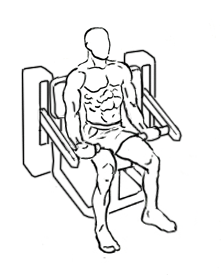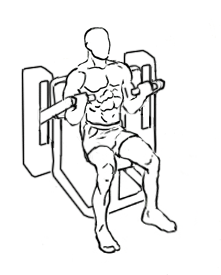Last Updated on September 24, 2014
The bicep curl is a fundamental exercise in any strength training regimen, targeting the biceps brachii muscles located at the front of your upper arm. While there are various methods to perform a bicep curl, using a machine offers distinct advantages, especially for those looking to ensure proper form and reduce the risk of injury. In this comprehensive guide, we will delve into the intricacies of performing a bicep curl with a machine, providing you with detailed instructions, benefits, and tips to maximize your workout.
Why Use a Machine for Bicep Curls?
Before diving into the steps, it’s essential to understand why using a machine for bicep curls can be beneficial. Machines are designed to guide your movements, ensuring that you maintain correct form throughout the exercise. This is particularly useful for beginners who may struggle with maintaining proper posture and alignment when using free weights. Additionally, machines can help isolate the biceps more effectively by minimizing the involvement of other muscle groups.
Setting Up for Success: Adjusting the Machine
The first step in performing a bicep curl with a machine is setting up the equipment correctly. Proper setup is crucial to ensure that you target the right muscles and avoid unnecessary strain on your joints.
- Adjust the Seat Height: Begin by adjusting the seat of the machine. The goal is to align your elbows with the machine’s rotation axis. This alignment is critical because it ensures that your arms move through the correct range of motion, maximizing muscle engagement while minimizing stress on your elbows and shoulders.
- Position Your Arms: Once you’ve adjusted the seat, position your arms against the pads provided by the machine. These pads are designed to keep your arms stationary throughout the exercise, allowing you to focus solely on curling your forearms.
Executing the Bicep Curl
With your setup complete, you’re ready to perform the bicep curl. Follow these steps carefully to ensure you get the most out of each repetition:
- Starting Position: Sit comfortably on the machine with your back straight and feet flat on the ground. Your arms should be pressed firmly against the pads, and your elbows should be aligned with the rotation axis.
- Curl Your Forearms: Begin by curling your forearms upward towards your shoulders. Focus on contracting your biceps as you lift. It’s important to keep your upper arms stationary; only your forearms should move during this phase of the exercise.
- Full Flexion: Continue curling until your arms are fully flexed. At this point, your forearms should be close to or touching your biceps. Hold this position for a moment to maximize muscle contraction.
- Controlled Descent: Slowly lower your arms back to the starting position. The descent should be controlled and deliberate, allowing you to maintain tension in your biceps throughout the movement.
Tips for Optimal Performance
To enhance your performance and ensure you’re getting the most out of this exercise, consider these additional tips:
- Focus on Form: Always prioritize proper form over lifting heavier weights. Incorrect form can lead to injuries and diminish the effectiveness of the exercise.
- Mind-Muscle Connection: Concentrate on feeling your biceps work during each repetition. This mental focus can enhance muscle activation and growth.
- Breathing Technique: Exhale as you curl your forearms upward and inhale as you lower them back down. Proper breathing can help stabilize your core and improve performance.
- Progressive Overload: Gradually increase the weight or resistance as you become stronger. This principle of progressive overload is key to building muscle over time.
Benefits of Machine Bicep Curls
Incorporating machine bicep curls into your workout routine offers several benefits:
- Isolation of Biceps: Machines allow for better isolation of the biceps compared to free weights, which often engage stabilizing muscles.
- Reduced Risk of Injury: The guided movement provided by machines reduces the risk of improper form and subsequent injuries.
- Consistency: Machines offer consistent resistance throughout the movement, ensuring that you’re working your muscles effectively from start to finish.
- Beginner-Friendly: For those new to strength training, machines provide an accessible entry point due to their simplicity and ease of use.
Common Mistakes to Avoid
While machine bicep curls are relatively straightforward, there are common mistakes that can hinder progress or lead to injury:
- Incorrect Seat Adjustment: Failing to align your elbows with the rotation axis can put unnecessary strain on your joints.
- Using Momentum: Avoid swinging or using momentum to lift the weight; this reduces muscle engagement and increases injury risk.
- Neglecting Eccentric Phase: The lowering phase (eccentric) is just as important as lifting (concentric). Ensure you lower the weight slowly and under control.
- Overarching Back: Maintain a neutral spine throughout; do not arch or hunch over as this can lead to back strain.
Incorporating Bicep Curls into Your Routine
To maximize muscle growth and strength gains, incorporate machine bicep curls into a well-rounded workout routine:
- Frequency: Aim for 2-3 sessions per week, allowing at least 48 hours between sessions for recovery.
- Sets and Reps: Start with 3 sets of 8-12 repetitions, adjusting based on your fitness level and goals.
- Combine with Other Exercises: Pair bicep curls with compound exercises like pull-ups or rows for comprehensive arm development.
The bicep curl with a machine is an excellent exercise for targeting and strengthening your biceps while ensuring proper form and reducing injury risk. By following these detailed instructions and tips, you’ll be well-equipped to incorporate this exercise into your fitness routine effectively. Remember that consistency and attention to form are key components in achieving optimal results in any strength training program. Whether you’re a beginner or an experienced lifter, mastering machine bicep curls can contribute significantly to building strong, defined arms.








